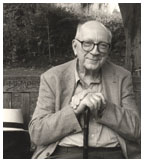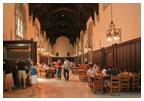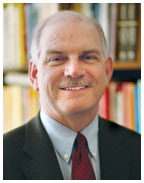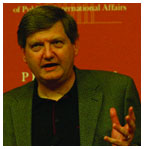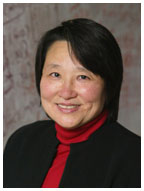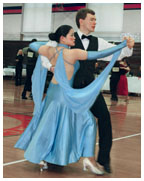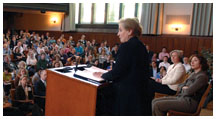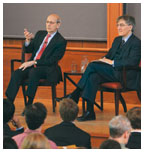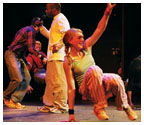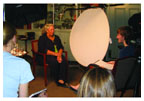
|
June 7, 2006: Notebook
A literary journalís roots in the Nassau Lit
Breaking ground – Electrical
engineering
Building trust between machines
Albright offers ‘14 points’ to help spread democracy
Breyer, George, and the Constitution
Ten professors move to emeritus status
Student filmmakers focus on the Atelier
A literary journal’s roots in the Nassau Lit
Frederick Morgan ’43 *52, above, co-founder of The Hudson Review. At left, the journal’s first issue, published in 1948, and the 55th anniversary issue, published in 2003. (Gaylen Morgan) (Denise Applewhite/Office of Communications) |
Buried within one of the 250 boxes of The Hudson Review archives recently purchased by Firestone Library is a clipping from a 1948 Time magazine with a photograph of two smiling young men.
The men are Frederick Morgan ’43 *52 and Joseph Bennett ’43, who founded The Hudson Review along with William Arrowsmith ’45. All three worked on the Nassau Literary Magazine, and even as Princeton undergraduates they had an eye toward founding their own literary magazine.
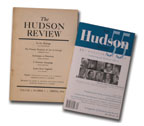 “It’s
a marvelous story because (Morgan) was a student in the first creative
writing class that Princeton had in 1939, taught by Allen Tate, the poet,”
said Paula Deitz, Morgan’s widow and current editor of The Hudson
Review. One day, she said, Tate pulled Bennett and Morgan aside and
told them, “You boys should start your own literary magazine.”
“It’s
a marvelous story because (Morgan) was a student in the first creative
writing class that Princeton had in 1939, taught by Allen Tate, the poet,”
said Paula Deitz, Morgan’s widow and current editor of The Hudson
Review. One day, she said, Tate pulled Bennett and Morgan aside and
told them, “You boys should start your own literary magazine.”
Of course, those were the war days; Morgan headed off to the Army, Bennett went into the Navy. But after the war, they met again in New York and picked up where they had left off. The Hudson Review began in 1948.
“They were soliciting contributions before The Hudson Review was founded,” said Don Skemer, Firestone’s curator of manuscripts. Skemer noted that the Review’s archives include letters that predate the journal’s founding, written on Nassau Lit stationery. “They were very ambitious; they went after famous authors. You could see the first lessons they learned going after good writers,” he said.
They were obviously successful: The archives include writings from a veritable “Who’s Who” list of literary giants, such as William Carlos Williams, T.S. Eliot, Anne Sexton, and Sylvia Plath. One of the most exciting portions of the archives, and the first to be researched, according to Deitz, are the six boxes of Ezra Pound material.
It’s a perfect end to the story, Deitz said, because Morgan always hoped that someone would research not only Pound’s “Cantos” and “Women of Trachis” — published for the first time in The Hudson Review — but also the poet’s connection to the journal (the archives contain 215 letters from Pound, most written to Morgan). Next month, poet Mark Jarman, a professor at Vanderbilt, will begin research on the project.
“In a sense, this is Fred’s last assignment,” Deitz
said. ![]()
By Hilary Parker ’01

Students have protested a plan to remove the traditional rows of tables from Madison, at top, and Mestres halls in favor of booths, banquettes, and smaller tables. (photo: John Jameson ’04; architect’s rendering: Mesher Shing) |
Preparing for the advent of the four-year residential colleges in fall 2007, the University has been developing plans to alter existing dining halls to provide “warm, intimate spaces.”
But after design sketches were released for the makeover of the collegiate gothic dining halls of Rockefeller and Mathey colleges — known to generations of alumni as Commons — the reaction from undergraduates was far from warm and fuzzy.
Nearly 600 students signed a petition protesting plans to replace the long rows of large tables with a mix of booths and smaller tables. An alumni petition drive followed. Letters in The Daily Princetonian criticized the new design as “more reminiscent of a Starbucks than a collegiate dining hall.” They said the design would ruin the “almost magical ‘Harry Potter’-type environment” of the dining halls, “sacrificing majesty for mediocrity.”
Chad Klaus, general manager for services in the University’s facilities department, said the administration was “reassessing” the design proposed by Mesher Shing, a Seattle firm.
“We are definitely taking the students’ concern and passion very seriously,” Klaus said. He said the outcome could range from “tweaking” the proposed design to more significant changes.
Mark Burstein, vice president for administration, said Rockefeller-Mathey
students support plans for new chandeliers, hanging banners, and changes
in food preparation and serving. The seating controversy, he said, centers
on striking the right balance between what is “uniquely Princeton
and what is changing in the world around us.” ![]()
By W.R.O.

H. Vincent Poor *77 (John Jameson ’04/Office of Communications) |
Engineering professor Stuart Schwartz, a 40-year faculty member, taught H. Vincent Poor *77 (he got an A) and hired him (to join the electrical engineering department in 1990). So when it was announced last month that Poor would become dean of the School of Engineering and Applied Science on June 1, Schwartz had a good sense of what Poor brings to the job.
“He has an amazing ability to keep a lot of balls in the air,” Schwartz said. “He’s easy-going, persistent, and he can be tough. They’re all good qualities that you need in a leader. He’s a good choice to help move the school forward.”
Poor, an authority on wireless communications and signal processing, has been recognized for his research and his teaching. He succeeds Maria Klawe, who led the process of developing a strategic vision for the school. Klawe resigned after three years as dean to become president of Harvey Mudd College in California.
“This is an extremely good time to be taking on this role,” Poor said. “The school is at the threshold of many things. There is a lot of opportunity for creativity.”
Poor listed the following among his five-year goals for SEAS:
• Construction of new buildings for the department of operations research and financial engineering (ORFE) and for materials science and bio-engineering.
• More involvement with the outside world, including a summer internship program for rising seniors and expanded relations with industry and government.
• Expansion of the Center for Innovation in Engineering Education, which Poor has served as the founding director. The center’s goal is to prepare both engineers and non-engineers to be leaders in a technological society; an initial project, an alternative freshman engineering curriculum, is being tested over three years.
• More faculty hires, especially for engineering in the life sciences and material science.
• More lab space for information technology.
The new dean also called for “very aggressive” promotion of the excellence of SEAS faculty and students. Citing the school’s relatively small size, its collaboration across departments, its focus on fundamental research, and its position within a world-class liberal arts institution, Poor said: “Princeton’s brand of engineering is very distinctive, and we need to promote that distinction.”
Poor said he expects to continue his research, though in a reduced fashion.
He expects to be traveling much of the coming year, especially to meet
with alumni. ![]()
By W.R.O.

|
(Beverly Schaefer) |
“This expansion of presidential power is similar to the early Cold War period when you had a kind of an abstract threat facing the United States. … When there is a threat and it is difficult for Americans to really gauge the scale of that threat, we are willing to do things … that we wouldn’t have done at other times.”
New York Times reporter James Risen, winner of the 2006 Pulitzer
Prize for national reporting, describing the Bush administration’s
efforts to break down limits on executive power since 9/11. Risen spoke
May 2 in Dodds Auditorium about his recent book, State of War: The
Secret History of the CIA and the Bush Administration. ![]()

Breaking
ground – Electrical engineering
Building
trust between machines
Professor Ruby Lee: Cyber-security is “absolutely essential.” (Frank Wojciechowski) |
As computers, communications, and entertainment have become increasingly integrated, users have put a new premium on protecting sensitive information with a combination of encryption, firewalls, and the latest antivirus software. But according to electrical engineering professor Ruby Lee, smart security needs to be included at a more basic level. Lee and several Princeton graduate students are working on a multi-university project called SecureCore that aims to incorporate worry-free, low-maintenance security in the hardware, software, and networking at the core of all computers, whether they operate on a desktop or inside a mobile phone.
“We’re trying to see fundamentally what you need to build trust between a user, his computing device, remote computers, remote users, and online services,” Lee says. “This is an extremely difficult problem, even philosophically, but if you really get to the crux of it, you may be able to eliminate causes of security breaches — causes rather than symptoms.”
Within the SecureCore project, Lee’s focus is on hardware — specifically the microprocessor, which she calls “the engine of the information age.” She worked in computer design at Hewlett-Packard for 17 years, including six years as chief architect, before joining the Princeton faculty in 1998.
Today’s microprocessors are designed for speed and performance, with little attention paid to security, which is provided through optional software. Rather than rely on software alone, Lee sees great potential in building a “safety net” in the microprocessor to catch threats that slip past the software. Lee’s design of a “secret-protected” architecture for microprocessors was the lead paper at last summer’s International Symposium on Computer Architecture. Beyond the academic community, her work is drawing attention from computer manufacturers as well as the Defense Advanced Research Projects Agency (DARPA), one of the SecureCore project sponsors.
University labs seem ideal for the type of fundamental rethinking of computer design that Lee and her colleagues have in mind, because academic researchers have the freedom to start with a clean slate. In industry, designers often have to work on incremental improvements in order to send a steady flow of new products to market. Lee, on the other hand, is free to take what she calls a “utopian view,” working to create a microprocessor that provides better security without sacrificing performance, cost, or usability. The last point is particularly important, she says, because when security is too cumbersome, legitimate users turn it off.
Lee says that while she enjoys being immersed in the academic world fulltime, she occasionally misses the thrill of putting her signature on the designs for computer components used around the world. But her design background continues to shape her work. At Princeton, she has developed two new processor architectures that could be commercialized for mobile computing — one for multimedia processing, and another for cryptographic processing — and the SecureCore project likely will lead to more designs.
“For me, research just for the fun of it is not enough,”
Lee says, “I want to see it have an impact in the real world, and
this is a topic that definitely does. Cyber-security is absolutely essential.”
![]()
By B.T.

(Beverly Schaefer) |
Graduate student Alexey Makarov and Patricia Li ’08 perform a tango
during the First Annual Clover Star Classic, a ballroom dance competition
April 30 co-hosted by the Princeton Ballroom Dance Club in Dillon Gym.
Twelve Princeton couples placed in the competition, taking 10 first places
in various dance events. The club, founded in 1983, competes and performs
several times a semester. The Clover Star Classic honors the late Neil
Clover, a dancer and volunteer Princeton instructor. ![]()

Albright offers ‘14 points’ to help spread democracy
Madeleine Albright, former secretary of state, called for more funding for democratic institutions in Iraq during a colloquium at Princeton. (Sameer A. Khan, courtesy the Woodrow Wilson School) |
In a speech at an April 28 colloquium honoring Woodrow Wilson 1879, former Secretary of State Madeleine Albright outlined “14 points for the 21st century,” a list of principles to guide America’s efforts to promote democracy abroad. Within her broad address, Albright criticized the Bush administration’s funding priorities in Iraq and urged the president to engage and push back against a growing list of countries such as China, Russia, and Iran whose leaders have shown “disdain for international norms.”
Albright, who returned to Georgetown University as a professor of diplomacy after leaving the State Department, credited President Bush for pursuing efforts to spread democracy, but she questioned his administration’s methods in a pointed critique of the invasion of Iraq.
Specifically, Albright said that while the United States continues to devote vast financial resources to the military effort in Iraq, its funding for demo-cratic institutions has been underwhelming. Establishing independent courts, organizing political parties, and building coalitions require time, she added, but each of those steps protects a new democracy from those who try to dismantle it. “If [a democracy] is to grow, it must put down roots,” Albright said. “Otherwise, it will not survive its first contact with the rougher edges of human nature.”
Albright fielded questions from the audience about U.S. relations with several countries, including Iran and North Korea. Her response on the latter included a lighthearted recollection of her official visit to meet North Korean leader Kim Jong Il in 2000. But in a more serious vein, Albright said that six years later, it is a dubious achievement that she remains the
highest-ranking U.S. official ever to meet with Kim. “It is essential
to talk with people that you disagree with,” Albright said. “We
cannot outsource our Korea policy to the Chinese. The North Koreans want
to talk to us.” ![]()
By B.T.
MORE ON THE WEB, click here: Madeleine Albright’s 14 points in her own words.

Breyer, George, and the Constitution
Justice Stephen Breyer, left, and Professor Robert George (Denise Applewhite/Office of Communications) |
A campus conversation between a moderate Supreme Court justice and a conservative legal scholar covered areas of philosophical agreement as well as differences.
The April 30 appearance of Justice Stephen Breyer and Robert George, the University’s McCormick Professor of Jurisprudence, attracted an audience that filled McCosh 50. Breyer outlined his approach to interpreting the Constitution, saying that its central idea is “creating democratic institutions.”
Breyer, who often votes in accordance with the court’s more liberal justices, emphasized that the Constitution was designed to function as a tool enabling citizens to be part of their government. “This document won’t work unless people take advantage of the opportunity it represents to participate,” he said. “We don’t need activist judges, but we do need activist citizens.”
George often has taken issue with the court’s liberal wing, but he enthusiastically supported Breyer’s call for a more activist democracy. Referring to Breyer’s book on the subject, George said, “It took me 50 pages to find something to disagree with. At some points, I was cheering. One of the things I most lament is that my students think that the Constitution is for the courts.”
George disagreed, however, with how Breyer has applied his conception of the Constitution to his judicial opinions. George asked, for example, whether it was the role of the legislature or the court to make decisions regarding campaign finance reform.
Breyer responded that the judiciary must ensure that the legislature’s
intentions in pursuing policies of campaign finance reforms are just.
“It’s the problem of the foxes guarding the chicken coop,”
he said. ![]()
By Adam Gottesfeld ’07

Ten professors move to emeritus status
Ten senior faculty members have transferred to emeritus status:
PAUL M. CHAIKIN, the Henry DeWolf Smyth Professor of Physics, has taught at Princeton since 1988. The co-author of Principles of Condensed Matter Physics, Chaikin conducted research in several key areas of the field. His labs were known for his students’ practical jokes, including a 55-gallon drum of peanut M&Ms students left one night in his office (he liked plain, not peanut).
JOHN V. FLEMING *63, the Louis W. Fairchild ’24 Professor of English and Comparative Literature, has taught the breadth of literary history in 40 years at Princeton — most notably the undergraduate Chaucer survey. A faculty tribute to Fleming said “few figures are as recognizably ‘Princeton’”; he has served as chief marshal and led the academic procession at Commencement for nearly 20 years, is the longest-serving college master in University history, chaired the English department, wrote a column for The Daily Princetonian for a decade, and posed for Maxim magazine in wool suit and silk bow tie.
STEPHEN R. FORREST, the James S. McDonnell Distinguished University Professor of Electrical Engineering, came to Princeton in 1992. He directed the Center for Photonics and Optoelectronic Materials, then chaired the Department of Electrical Engineer-ing. Forrest studied fundamental issues surrounding photonic materials, devices, and systems and researched more efficient room lighting.
JOHN G. GAGER JR., the William H. Danforth Professor of Religion, came to the University in 1968. The author of controversial and influential books on early Christianity and ancient anti-Semitism, his signature course was Religion 251, “The New Testament and Christian Origins,” credited with helping to bring hundreds of majors to the religion department over the years.
WU-CHUNG HSIANG *62, professor of mathematics, began teaching at Prince-ton in 1972. An influential topologist, he chaired the mathematics department from 1982 to 1985.
PETER CHUNG-YI LEE, professor of civil and environmental engineering, came to Princeton in 1966. He has taught continuum mechanics and elastodynamics; his research has focused on high-frequency vibrations, finite-element modeling of different physical systems, and piezoelectric materials.
TONI MORRISON, the Robert F. Goheen Professor in the Humanities, joined the faculty in 1989. A distinguished novelist, essayist, and lyricist, she was awarded the Nobel Prize in Literature in 1993. Morrison was the founding director of the Princeton Atelier, which brings noted artists to campus to collaborate on creating works with students, and has been associated with the programs in Creative Writing and African-American Studies.
THEODORE K. RABB *61, professor of history, has taught at Princeton since 1967. An author of early modern European and British history, Rabb has been a demanding and innovative teacher known for his essays and reviews. In the 1970s he coordinated the development of a popular interdisciplinary introduction to the culture of Europe from the Renaissance. He helped create Humanities 216-219, a four-course sequence on the history of Western culture that he directed.
JOSEPH H. TAYLOR, the James S. McDonnell Distinguished University Professor of Physics, came to Princeton in 1980 as a leading radio astronomer. In 1992 he won the Wolf Prize; he and his wife donated the $100,000 in proceeds to establish a graduate fellowship in the physics department. In 1993 he and Russell Hulse were awarded the Nobel Prize in Physics for determining a way to verify the existence of gravitational radiation. Taylor served as dean of the faculty from 1997 to 2003.
ROBERT L. TIGNOR, the Rosengarten Professor of Modern
and Contemporary History, joined the faculty in 1960. A distinguished
historian of the Third World, Tignor directed the Program in African Studies
and then chaired the history department for 14 years. He helped transform
the department by supporting more interdisciplinary international studies.
![]()

(Frank Wojciechowski) |
Antonina Savostyanova ’06, foreground, and Olawale Oladehin ’07,
with microphone, perform a routine during the spring show at Frist Campus
Center of Sympoh Urban Arts Crew, a student breakdancing group. ![]()

Student filmmakers focus on the Atelier
Professor Toni Morrison is interviewed in the Maclean House library by students for their documentary class videos on the Princeton Atelier. (Courtesy Katherine Carpenter ’79) |
The Princeton Atelier, founded by Nobel laureate Toni Morrison 12 years ago, is all about the creative process — bringing professional artists to campus to develop a project in collaboration with students.
So when a documentary filmmaking course set out to capture the “mystery of the Atelier,” in the words of instructor Katherine Carpenter ’79, it was no surprise that the course participants learned to expect the unexpected. On one key day of filming late in the course, Carpenter said, “We had six camera crews at work, and none of them were where they had thought they were supposed to be.”
Fourteen students signed up for the course with Carpenter, a visiting Ferris professor and veteran documentary filmmaker whose latest production is A Year on Earth. The students worked in small groups to produce a series of five-minute documentary videos tied to the Atelier process.
One team focused on an Atelier in which actress Maria Tucci, dancer Allegra Kent and classicist Daniel Mendelsohn worked with student actors, singers, and dancers in a production that combined elements of Euripides’ Alcestis and A Winter’s Tale by Shakespeare. “In the end, it was a powerful story,” Carpenter said. “It did what an Atelier is supposed to do. The students filming saw how, out of chaos, in the end the pieces did come together.”
The students taped a one-hour interview with Morrison, the Robert F. Goheen Professor in the Humanities who moved to emeritus status at the end of the term. The students’ videos may be posted on the Atelier Web site during the summer, Carpenter said.
Tom Bender ’06 said the class’ work was “unusual and worth filming,” but some shoots were difficult to schedule and “somewhat intrusive” to the Atelier participants. He described the experience as “the sort of hands-on, production-oriented course that Princeton needs more of.” One of the students will work this summer with documentary filmmaker Al Maysles, who attended a class session; three others will have summer jobs in television or film.
Carpenter said she realized the class was “really getting it”
when one student borrowed the camera equipment for a weekend, then came
back with an idiosyncratic short film about cheerleading. “I had
no idea that, simmering below the surface of this physics scholar, was
a quirky filmmaker waiting to be born,” she said. ![]()
By W.R.O.

Dean of Admission Janet Rapelye said that Princeton needs to do a better job of publicizing its no-loan financial aid policy and demystifying the everyday life of the eating clubs, based on the findings of a University-commissioned MARKETING STUDY led by Widmeyer Communications of Washington, D.C. The study gauged how high school students, their parents, and their guidance counselors perceive Princeton. In focus groups, students frequently mentioned the eating clubs and expressed confusion, Rapelye said, partly because the University does not fully address the clubs in its publications. The study also found that parents were unclear about what made Princeton’s aid package distinctive. Rapelye said that the study gave the admission office ideas for strengthening the University’s message. “We’re not interested in changing the message of Princeton,” she said. “We’re interested in changing the perceptions of Princeton, if they’re not right.”
Princeton Journeys, the Alumni Association’s travel program, admits that a trip it is sponsoring to NORTH KOREA this summer is unusual: It will be “very controlled” with no opportunities for independent travel, and visitors will be “expected to bow as a gesture of respect at the statue of Kim Il Sung,” the country’s late leader. As of mid-May, 18 people had signed up for the $6,360 trip Aug. 23–Sept. 3, including five Harvard alumni who joined the group after Harvard’s alumni association canceled a similar trip, citing low demand and other problems, including insurance. The cancellation followed an opinion piece in the New York Post in which a Harvard graduate wrote, “Something is very wrong when Harvard ... feels comfortable instructing its alums to bow down to evil thugs.”
According to the U.S. Department of State, North Korea, which is normally closed to American tourists, has rejected international norms of human rights, prohibits free movement and association, and severely restricts academic freedom. Princeton Journeys said the visit — which features attendance at the Arirang Mass Games, featuring large-scale synchronized gymnastics and displays of colored cards — “can lead to greater cultural awareness and understanding.” Leslie J. Rowley, executive manager for Princeton Journeys, said her office had received no reaction critical of the trip.
On May 1, the Council of the Princeton University Community added “GENDER
IDENTITY AND EXPRESSION” to the list of protected personal
characteristics and beliefs outlined in the “Respect for Others”
section of Princeton’s Rights, Rules, Responsibilities
guide. Professor Angela Creager, chairwoman of the rights and rules committee,
said the list was last updated in 1985, when the CPUC added sexual orientation
to a list that included sex, race, ethnicity, national origin, religion,
and handicap. Protected personal characteristics, the guide notes, are
not limited to the ones mentioned explicitly. ![]()

